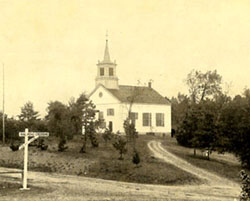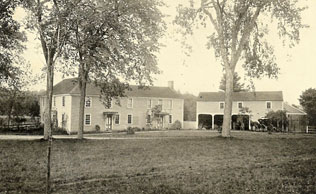|
The
Town of Dover began as the Fourth
Precinct of Dedham, Springfield Parish, in
1748.
It was separated as
the District of Dover in 1784 and became the Town
of Dover in 1836.
The history of Dover
can still be seen in buildings and sites existing
today.
The first Meetinghouse was
raised
in 1754 and its first minister, the Reverend Benjamin
Caryl, accepted the call in 1762, serving for fifty
years. At this time, there were 352 inhabitants and 49
houses in Dover. (The image below, left, shows the First Parish Church, c.
1910)
 In addition to ministering to his parishioners,
Benjamin worked his farm and prepared young men for
college.
His theology appears to be standard for the period,
but
it is noteworthy that in his sermons he changed his
opinion
regarding involvement in the American Revolution.
In In addition to ministering to his parishioners,
Benjamin worked his farm and prepared young men for
college.
His theology appears to be standard for the period,
but
it is noteworthy that in his sermons he changed his
opinion
regarding involvement in the American Revolution.
In
December 1766 he suggested the Parish
"be
sensible of the mercy of God in continuing to
us our sovereign and the happy government which
at present we are under."
But by March 1776,
he thought that
"[w]e doubt not that the omnipotent hand of
our heavenly Father is ready to stretch forth and
save us."
 After the Meetinghouse,
the next most prominent building in a Colonial town was
the tavern. After the Meetinghouse,
the next most prominent building in a Colonial town was
the tavern.
The Whiting
Tavern (later
known as the Williams Tavern under the ownership of John
Williams), was lost to fire on January 24,
1908. It was originally built by Daniel Whiting in 1761.
Daniel served in the French and Indian Wars of 1758-1763.
He reentered military service when he answered the Lexington
Alarm on 19 April 1775. His tavern served as the meeting
place of the Sons of Liberty.
The Training Ground, where
Minutemen drilled, is across
the street from the tavern's site. The image on the left, below, shows
the Training Field c. 1910.
 On April 19, 1775,
66 Dover Minutemen marched to fight along Battle Road
under
the command of Captain Ebenezer Battelle. On April 19, 1775,
66 Dover Minutemen marched to fight along Battle Road
under
the command of Captain Ebenezer Battelle.
Elias Haven had been at work harrowing a field on the
Chickering farm (still operating at 56 Haven Street)
that morning. According to tradition
he left his harrow in the field to answer the call
to
arms, and "was [later] shot down while
standing beside his brother-in-law,
Aaron Whiting, at a corner of the Arlington meeting-house
and is buried near the spot."
He
was the only Dedham man killed that day. The harrow
he abandoned
is now in the Fisher Barn.
Daniel Whiting led a company at the Battle
of Breed's Hill in 1776 as a major, ending the war
as a Lieutenant Colonel in the Continental Army.
Private Thomas Larabee, according to Dover tradition,
helped row General George Washington across the Delaware
River,
at Trenton, New Jersey, on December 26, 1776.
His
powder horn (see image above) and numerous artifacts
from an archaeological dig on
his property in the 1970's are on display at the
Sawin Museum.
Slate gravestones mark the graves of Revolutionary War
soldiers in the front rank of the Highland
Cemetery, on Centre Street, across from
The Old Training Ground.
Visit www.masshome.com/hist.html for
more information on other
Historic Sites in the Boston area.
| back to top |
The Dover Historical
Society
PO Box 534
Dover, MA 02030
info@doverhistoricalsociety.org
|

